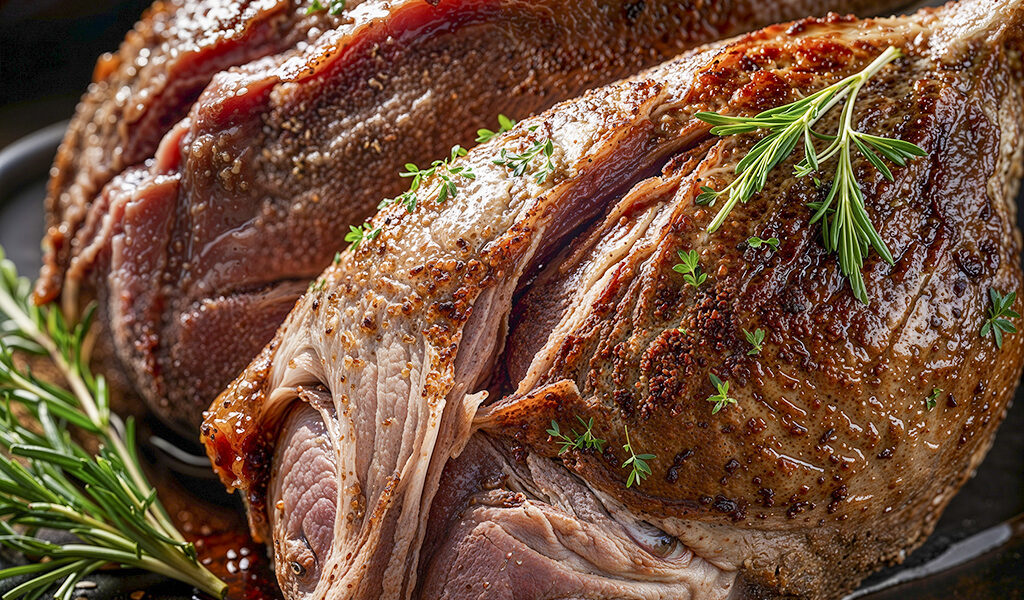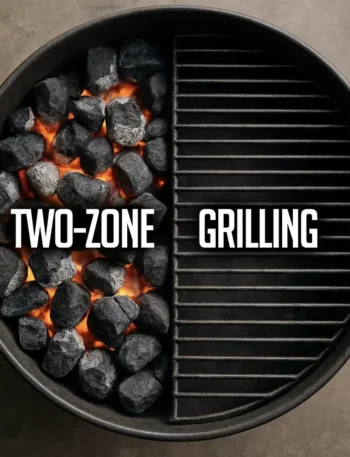How to Roast the Perfect Leg of Lamb: A Home Cook’s Guide
Roasting a leg of lamb is an art that combines tradition, precision, and understanding the character of this exceptional meat. Leg of lamb, known for its tenderness and juiciness, is one of the most prized cuts in Mediterranean, Middle Eastern, and many other cuisines. It features a unique, intense, rich flavor reminiscent of game meat. The taste of lamb has its own distinctive qualities. Lamb meat has a natural, subtle sweetness that distinguishes it from other types of meat. This note is particularly noticeable in young lamb, which has a milder taste than older sheep. It’s worth paying attention to this when making your purchase. Mutton (meat from older sheep) has a more intense and pronounced flavor similar to game. This results from the fat content and specific fatty acids that develop as the animal ages. Sheep feed on grass, herbs, and other plants, which gives their meat an earthy, natural character. This very pronounced flavor of mutton can be overwhelming and even off-putting for many people. The taste of mutton can be tempered by marinating, removing excess fat, or cooking slowly at low temperatures. Adding vegetables, broth, wine, or using intense spices during cooking not only enhances the flavor but also balances its intensity.
Roasting lamb is easier than it might seem, but the entire process requires understanding how temperature affects the meat’s structure, how to control the degree of doneness, and how to bring out the best flavors. Each method of preparing this noble cut of meat leads to different end results, depending on your culinary preferences.
The degree of doneness is a matter of personal choice that significantly impacts the final result and preparation method. Rare meat maintains a pink center and maximum juiciness – this is the choice for lovers of the intense, natural flavor of lamb. Medium-rare offers a slightly pink center with more cooked portions while still retaining juiciness. Medium is the golden middle ground – the meat is light pink in the center, well-set, but still juicy. Well-done means fully cooked meat without a pink center, but still maintaining its structure. A separate category is meat roasted for hours at low temperatures, which literally falls apart under the fork – such a method, however, requires a completely different approach to preparation and cooking time.
Regardless of your preferred degree of doneness, the key is understanding how to achieve the desired effect and how to ensure the meat remains juicy and aromatic. Equally important is proper preparation before roasting and appropriate handling after removing from the oven, which I will discuss later in this article.
Preparing the Leg of Lamb
Roasting a leg of lamb is a process that begins at the stage of selecting and preparing the meat. Proper preparation ensures that the meat will be juicy, aromatic, and perfectly cooked. Always choose meat from a trusted source, preferably from a local supplier or organic farm. A fresh leg of lamb should have a light pink or pink-red color, with cream-white, firm fat. In lambs (up to 12 months), the meat has a particularly light, delicate color. Mutton is noticeably darker with an intense red or red-brown hue. The fat is usually more yellowish and harder compared to lamb. With age, muscles contain more myoglobin, giving the meat a darker color. Remember, however, that the color may vary slightly depending on the animal’s breed, diet, and farming conditions. When choosing a leg of lamb, you have the option of bone-in or boneless. Bone-in meat is more flavorful because the bone releases additional taste and juices during roasting. However, it requires more attention when serving and can be more difficult to carve. Boneless meat is more convenient to prepare and serve, and it’s also easier to control its doneness. However, the absence of bone makes the meat more susceptible to drying out, so it requires careful monitoring of cooking time and temperature. Regardless of your choice, both versions can yield excellent culinary results with proper preparation.
Nutritional Aspects of Roasted Leg of Lamb
The nutritional value of roasted leg of lamb can vary significantly depending on several key factors. Meat quality plays an essential role – lamb from organic farms often contains higher levels of beneficial nutrients, especially omega-3 fatty acids. Fat content affects not only the caloric value but also the taste and juiciness of the meat. The roasting process itself also influences the final nutritional profile, with longer cooking times leading to greater water loss and, consequently, higher concentration of nutrients per 100g of meat.
It’s worth noting that the vitamin content in cooked lamb may be 20-30% lower compared to raw meat, and overall nutritional values can vary by ±15-20% depending on factors such as breed and age of the animal, farming methods (grazing versus feed), and even the slaughter season. A typical 200-250g portion of roasted lamb provides about 450-500 calories, making it a satisfying main dish that is best complemented with plenty of vegetables and a moderate portion of carbohydrates.
Cooking Time for Leg of Lamb
How long the lamb will roast in the oven depends on how you like it. For medium-cooked lamb, which is perfectly pink in the center, plan about 20 minutes per pound (about 0.45kg) or until the internal temperature reaches about 55°C (130°F) to 57°C (135°F). This will take about 1 to 1.5 hours in an oven preheated to 180°C (355°F). For meat that should fall apart, plan about 30 to 35 minutes per pound or until the internal meat temperature reaches 80°C (175°F) to 90°C (195°F). This may take 3.5 to 4.5 hours in an oven preheated to 180°C (355°F).
Internal Temperature Guide for Roasted Leg of Lamb
The meat will rest for a while after removing from the oven (I recommend a minimum of 30 minutes), and its internal temperature will rise during this resting period. This should be taken into account when roasting. For me, leg of lamb is best when it’s perfectly pink in the center (internal temperature around 55°C (130°F)), and for my loved ones, when it’s roasted for long hours until it becomes very tender and falls apart (internal temperature around 80°C (175°F)). Here’s a quick table:
- Rare: About 15 minutes per pound (0.45kg) or until reaching an internal temperature of 52°C (125°F).
- Medium-Rare: About 20 minutes per pound or until reaching an internal temperature of 55°C (130°F) to 57°C (135°F). Roasting time will be about 1 to 1.5 hours in an oven preheated to 180°C (355°F).
- Medium: About 25 minutes per pound or until reaching an internal temperature of 57°C (135°F) to 60°C (140°F).
- Well-Done: About 30 minutes per pound or until reaching an internal temperature of 68°C (155°F) to 74°C (165°F).
- Falling-Apart Tender Lamb: About 40 minutes per pound or until reaching an internal temperature of 80°C (175°F) to 90°C (195°F). This may take about 4 to 4.5 hours in an oven preheated to 180°C (355°F).
Recommendation for Using a Meat Thermometer
To avoid guesswork and achieve a perfectly roasted leg of lamb, always use a meat thermometer. It’s the only way to accurately check if the meat has reached the desired internal temperature. Insert the thermometer into the thickest part of the meat, avoiding the bone, as this can falsify the reading. Wait a few seconds before reading to allow the thermometer to stabilize. Remember that the meat will continue to cook after removing from the oven (called carryover cooking), so remove it when the temperature is 3-5°C (5-10°F) lower than your target.
Kitchen Equipment – Technical Aspects
The vessel in which we prepare the leg of lamb is crucial for the final result. A roasting pan with a rack works best – it allows fat to drain freely to the bottom while heat evenly surrounds the meat. When planning long, low-temperature roasting, especially with added vegetables or broth, an ovenproof dish is worth considering. Some chefs like to quickly sear the meat in a cast-iron skillet before putting it in the oven – it’s a great way to bring out the full flavor and achieve the right texture.
It’s also worth knowing the difference between a convection oven and a conventional one. The one with a fan cooks faster and more evenly. However, remember to lower the temperature by 10-20°C (50-68°F) compared to a recipe written for a conventional oven. In a traditional oven, we need to be more vigilant and turn the meat during roasting to ensure it cooks evenly on all sides.
A meat thermometer with an alarm is invaluable. Just set the desired temperature – for example, 55°C (130°F) for medium-cooked meat – and you don’t have to guess whether it’s properly cooked. It will turn out just as well every time.
Resting the Meat
After roasting, allow the meat to rest for at least 30 minutes before carving. This allows the juices inside the meat to distribute evenly, making the meat more juicy and flavorful. Cover it loosely with aluminum foil to retain heat.
Professional Carving Techniques
The proper carving technique has a significant impact on both presentation and culinary experience. After the crucial resting period of at least 30 minutes, place the leg of lamb on a stable cutting board. The bone usually runs through the meat at an angle, creating two main sections to carve.
Start with the more accessible section, positioning your knife perpendicular to the bone and cutting across the grain. Begin at the thickest part, making straight cuts down to the bone. Continue along the bone until you’ve carved the entire section. Then, turn your knife parallel to the bone to separate the slices, working from the end furthest from you.
After transferring the first set of slices to a warmed serving platter, turn the leg and repeat the process with the second section. Though this may be slightly more challenging due to the angle of the bone, the same methodical technique applies. Don’t overlook the smaller pieces of meat remaining on the bone – they’re perfect for other dishes, and the bone itself can be used to prepare an aromatic broth.
The importance of cutting across the grain cannot be overstated. This technique ensures more tender, easier-to-chew meat by shortening the muscle fibers, resulting in optimal texture and enhancing the culinary experience.
Safe Storage, Handling, and Hygiene
Proper storage and handling of meat are crucial for both safety and quality. Fresh lamb should be stored in a refrigerator at 0-4°C (32-39°F), while frozen meat requires a temperature of -18°C (0°F) or lower. When working with frozen lamb, proper thawing is essential – transfer the meat from the freezer to the refrigerator 24-48 hours before cooking, avoiding thawing at room temperature to prevent bacterial growth.


